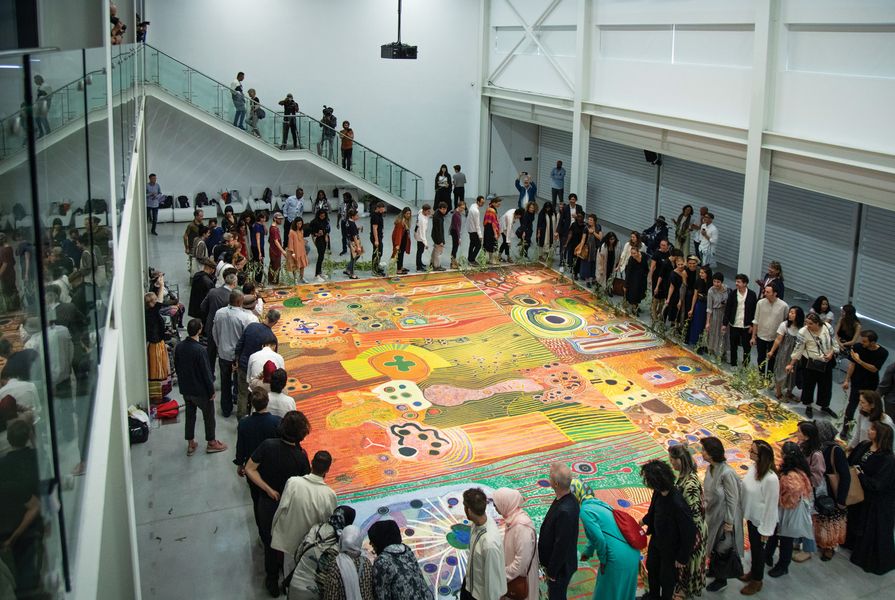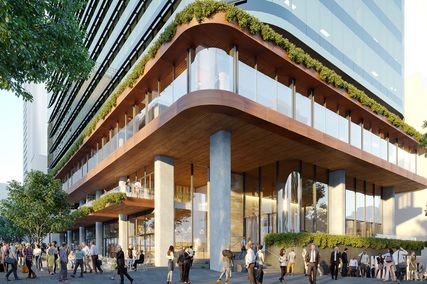The first major platform for architecture and urbanism in the region, billed as “an archipelago of struggles,” focused not on new buildings but on the crises affecting our planet and the multitude of ways in which human interventions are affecting ecological balance. Stephen Todd visited the capital of the Emirate of Sharjah to experience the alternative visions that are at the core of the triennial, curated by Australian architect and designer Adrian Lahoud.
Under the banner “Rights of Future Generations,” the Sharjah Architecture Triennial opened in November 2019 with a procession of local mariners bearing a model of a traditional wooden dhow to an abandoned market, followed by a group of Sunni choristers chanting songs that accompany the hajj (the annual pilgrimage to Mecca). Later that day, an Egyptian troupe staged part one of a performance exploring the legacy of the Suez Canal, the conduit through which the marine ecologies of the Red Sea and the Mediterranean co-mingled, changing both forever. The remainder was performed on the days that followed.
The message was clear: this inaugural edition of the first major international platform on architecture, urbanism and the environment situated in the Arabic-speaking world would be grounded in Sharjah’s position as a historical port of Indian Ocean trade, taking in parts of Africa, the Middle East and South and Southeast Asia.
The Sharjah Architecture Triennial’s opening included a procession as part of Silences and Spectres of the Indian Ocean , an examination of relations formed through sailing vessels by anthropologist Nidhi Mahajan.
Image: Talie Eigeland
The triennial installations were spread throughout three main venues – the abandoned Souq Al Jubail vegetable market, the disused Al-Qasimiyah School and the Al Mureijah Art Spaces, a renovated precinct that was shortlisted for the 2019 Aga Khan Award for Architecture. As a collection, they conveyed that, for curator Adrian Lahoud, it was important to consider Sharjah as somehow part of the wider “Global South,” that World Bank category denoting low- and middle-income countries located in Africa, Latin America, Asia and the Caribbean. The same categorization can also be applied to the Indigenous population of Australia.
Over subsequent days and nights, I and others attending the opening program participated in an “awakening ceremony” by walking around the Ngurrara Canvas II , brushing the edges of its spectacular patchwork of colours with the tips of eucalyptus branches. We reclined around the ruins of the Mleiha Fort at sunset and listened to the boom of speakers buried beneath the desert, seemingly echoing from across time. (The fort is built on a site at which artefacts have been found dating back 130,000 years, making it a claimant to the “cradle of civilization” title.) After this, we entered the fort and watched a screening of O Horizon by the Otolith Group, a film made in Santiniketan, home of the famous Bengal School of Art.
What we didn’t do was look at a lot of new buildings – not even models of new buildings – nor talk much about new buildings. (Except, perhaps, to whine about our hotel, which kept the airconditioning pumping day and night.) Like the 2019 Chicago Architecture Biennial, the Sharjah Triennial eschewed a frontal approach to architecture, instead shifting focus to the crises that are affecting our planet.
On display in a darkened room, The Atacama Lines featured photographs of ancient geoglyphs carved into the South American desert gradually mutating into signs of invading European life.
An installation of videos and displays by the Feral Atlas collective, a group of more than seventy designers, scientists and artists, presented in graphic terms the multitude of ways in which human interventions on the surface of the earth – dams, highways, fishing farms and so forth – are affecting ecological balance and hurtling us deep into the Anthropocene Age. “We’re interested in presenting the hubris of human intervention and so-called mastery of the natural world,” says Jennifer Deger, co-curator of the installation along with Victoria Baskin Coffey. “We’re always trying to find compelling ways to get people to stay with it as we present more terrible stories at a time of widespread exhaustion,” adds Baskin Coffey. The pair are graduates of James Cook University, Queensland.
Billed as “an archipelago of struggles,” the Sharjah Architecture Triennial drew on the work of architects, designers, engineers, activists, performers, choreographers, scientists, musicians and anthropologists to present a portrait of climate catastrophe, indigenous land claims and illegal occupation, in order to reveal the compromised rights of generations to come. “The triennial is uniquely positioned to respond to the opportunities and challenges faced by an emerging generation in the region, in terms of decolonization and its legacies, emancipatory struggles, institution building and the fragmentation of historical archives,” says Lahoud, who is the dean of the School of Architecture at the Royal College of Art, London. “But I didn’t want to do a stereotypical exhibition of work from people of the Global South, applying my definition of experimentation and tradition to their cultural production.”
Ngurrara Canvas II , created by Indigenous artists from Australia’s Kimberley region as an expression of their links to Country, was a highlight of the program.
Image: Talie Eigeland
Lahoud seems most ebullient when talking about the Ngurrara Canvas II, the eighty-square-metre collaborative painting made by forty Indigenous artists from four language groups in Australia’s Kimberley region. The artists came together in 1997 to depict a massive swathe of their land as evidence of their claim to native title. Ten years later, the claim was officially recognized, with Federal Court Justice John Gilmour stating: “… the Court does not give you native title. Rather, the Court determines that native title already exists. It determines that this is your land. That it is based upon your traditional laws and customs and it always has been. The law says to all the people in Australia that this is your land and that it always has been your land.”1
In April 2019, Lahoud travelled to the Karrayili Adult Education Centre in Fitzroy Crossing to meet surviving artists and nominated descendants of the deceased artists to explain his ambition for the triennial and to listen to their aspirations for the canvas. “What I realized early on was that my definition of experimentation and tradition was kind of irrelevant,” Lahoud recalls. “It was a real discovery for me to learn that what matters is their definition of radicality, not my idea of how it is represented.” It’s this openness to other ways of seeing that is at the core of Lahoud’s triennial. Even when those alternative visions are directed at the host city itself.
One of seven United Arab Emirates, Sharjah is the third-largest city-state after Abu Dhabi and Dubai. While it doesn’t have the flagrant development profile and imported cultural ambitions of its neighbours – no “starchitect” buildings nor franchises of the Louvre – it does have ambient human rights abuses (in 2018, a well-known human rights activist was sentenced to ten years’ jail time for some tweets that displeased authorities). The emirate also over-consumes water to irrigate its European-style lawns (considered a sign of prestige), guzzles electricity to keep its airconditioning pumping and uses petrol in obscene quantities to fuel its turbocharged SUVs. Some of the most interesting installations at the triennial tackled these issues directly.
Becoming Xerophile, by London-based studio Cooking Sections, challenged the idea of the desert as a bare landscape and prototyped a new model of urban gardens for arid cities such as Sharjah.
Outside the Al-Qasimiyah School – which is being restored to become the headquarters of the triennial – London-based studio Cooking Sections installed Becoming Xerophile a new topography of brick-lined sand bowls designed to create viable microclimates that shield plants from wind and collect water from condensation to irrigate them. “The nurseries here in the UAE don’t grow desert plants because they’re not seen as ornamental,” said Alon Schwabe of Cooking Sections during the opening. “We want to propose an alternative model for non-irrigated urban gardens in Sharjah and other arid climates, bringing the desert back into the city.” The sand bowls have been equipped with sensors that will monitor them until the next triennial – part of a pledge to create sustainability in the architectural festival itself.
The dearth of water is also an issue in the Atacama Desert in northern Chile, where the Quechua people are doing battle with global mining conglomerates for rights to precious supplies. As the Ngurrara language groups in Australia’s Great Sandy Desert got together to paint their canvas depicting historical rights to some 76,000 square kilometres of land, so too the Quechua are using ancient geoglyphs carved into the mountainous topography of the Atacama Desert to stake their heritage claim. At the triennial, The Atacama Lines project featured a darkened room in which backlit aerial photographs emanated an otherworldly glow, picking out glyphs in the form of native fauna and religious symbols, gradually mutating into signs of European life as the invading population literally made its marks.
According to Sheikha Hoor Al Qasimi, daughter of Sharjah’s ruler and chairperson of the triennial, “Living so close to Dubai, we’re always questioning what architecture is and could be. For us in Sharjah, it’s about more than just big buildings, it’s about the many different layers and how different parts of the community come together, about the ceremonies and the canteens and the identity [that] is embedded in the city itself.”
1. Larissa Behrendt, “Ngurrara: The Great Sandy Desert Canvas,” Aboriginal Art Directory, 17 June 2008, aboriginalartdirectory.com/news/feature/ngurrara- the-great-sandy-desert-canvas.php (accessed 25 November 2019).
The Sharjah Architecture Triennial runs 9 November 2019 – 8 February 2020 in Sharjah, United Arab Emirates.
Source

Discussion
Published online: 1 Dec 2019
Words:
Stephen Todd
Images:
Talie Eigeland
Issue
Architecture Australia, January 2020























